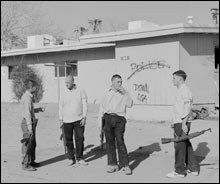
29 PALMS: SASO, IRAQI POLICE: The Marines are much more serious than the re-enactors, the photos seem to say, but it’s still a game. |
“I don’t think there’s a soul who likes that place,” Dan Cook tells me about 29 Palms when I walk over to his Dorchester apartment. As American troops advanced up Iraq during the initial invasion in 2003, the wiry redhead hopscotched from one helicopter camp to another behind the wheel of a four-wheel-drive military fire truck, dodging potshots in cities along the way. The 21-year-old was part of a Marine crash-fire-rescue team that doused fires and raced to choppers that had fallen from the sky.
That autumn, he rotated back to the States and after a few months was posted to the airfield on the godforsaken Mojave Desert base, three-quarters the size of Rhode Island, known as 29 Palms. “The kids we took over for were like, ‘Dude, I’m sorry for you guys.’ ”
I was hoping Dan (not a relative but the brother of a good friend of mine) might help me better understand the black-and-white pictures of Marines training for Iraq and Afghanistan at 29 Palms that make up part of New York photographer An-My Lê’s 50-photograph exhibit “Small Wars” at the Rhode Island School of Design Museum. The other part of the show, which was organized by the Museum of Contemporary Photography at Columbia College in Chicago, is her earlier photos of Vietnam War re-enactors. Lê was born in Saigon in 1960, at which time the war consisted of political coups and random shelling of the city by the Vietcong every night. During the 1968 Tet offensive, the Communists briefly took over the American embassy and the radio station behind her house. That was when she got her first glimpse of the mysterious enemy — dead in the streets. Americans evacuated her family when the South fell to the Communists in 1975. She wound up a refugee in California.
After earning an MFA from Yale in 1993, Lê made several trips to Vietnam, photographing farmers, their fields and their ducks, ruined buildings, a kite festival, blurry boys playing soccer in an urban courtyard. Her memories of her homeland had become jumbled with war photos and war movies. She realized her subject was the “the Vietnam of the mind.”
She returned to the US feeling ready to address the war. She’d heard of men re-enacting the Vietnam War in the woods of Virginia; beginning in 1999 she arranged to spend parts of four summers there and in North Carolina documenting the pretend fighting. “I was just interested in the idea of the war and how it’s still lingering and how it’s so raw,” she tells me when I reach her in Manhattan. “It’s just so mythologized.”
In one lyrical photo, Americans fire into a cloud of smoke obscuring a rocky creek during an “ambush.” Elsewhere, they surround a downed American jet, the pilot hanging limp from the cockpit. They warily patrol a grassy field, the camera peering up through the blades from behind. They plop down in the dirt for a breather. Occasionally Lê appears as a black-clad Vietcong sniper, hidden in dune grass or in the hollow of a hill, lying in wait for the GIs. Some scenes are surreally beautiful, like the streaking sparks of an explosion in the woods at night.
The re-enactors are trying to get the look, the gestures just so. We’ve seen the photos and the movies that they’re aping, and Lê’s uninflected images reveal how the whole thing feels off — the pine forest is wrong, the explosion looks like fireworks. But what’s really missing is the urgency of the real thing. I call my friend Marc Levy of Gloucester, who was a combat medic in Vietnam. “When I see this stuff, it burns me up, because they’re just clueless. They have no idea of the terror, no idea of the suffering, no idea of the horror.”
March 19, 2003, the day the war in Iraq began, Lê started trying to get embedded with American troops. She couldn’t land a slot at that late date, but photos she saw of Marines practicing at the branch’s premier training facility, 29 Palms, prompted her to write for permission to photograph there. It would continue her exploration of playing war. She made her first visit in July 2003 and has returned there and to other California bases 10 times since.
“I am not categorically against war, but I feel the decision makers and policy makers have no idea how devastating the effects of war can be,” she writes in Small Wars, a collection of her photos published by Aperture last year. “War just seemed unreasonable and unjustified in this case.”